A goal apiece in quick succession in the first half meant Milan and Napoli drew 1-1 at the San Siro on Saturday night. The result was not ideal for either side. Milan failed to get into the top half of Serie A while Napoli lost even more ground on the top teams. In this tactical analysis, I am going to look at the interesting tactical talking points from both sides’ tactics. The analysis will look at the build-up patterns of both sides and how Milan tried to press Napoli.
Lineups
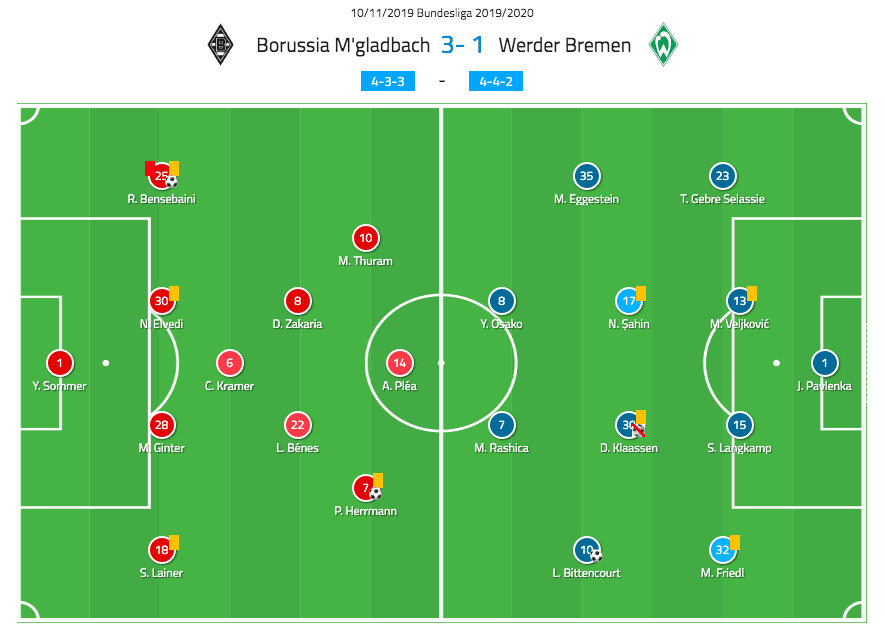
Stefano Pioli opted for a 4-3-3 which included a very attacking central midfield with Rade Krunić and Lucas Paquetá ahead of Lucas Biglia. Either side of Krzysztof Piątek were Giacomo Bonaventura and Ante Rebić, both of whom performed very different roles.
Carlo Ancelotti’s Napoli lined up in a very fluid shape that was a 4-4-2 without the ball. This lineup saw Allan partner Piotr Zieliński in central midfield with José Callejón and Eljif Elmas starting in the wide areas with Lorenzo Insigne partnering Hirving Lozano up front. However, as we will see, Napoli’s attacking shape was very different due to their rotations.
Tactical analysis: Milan’s build-up patterns
As mentioned, Milan started in a 4-4-3 and it was very clear what Pioli wanted them to do. Firstly, the centre-backs were mostly spread wide with Biglia dropping in between them or, as was often the case, positioned himself behind Napoli’s front-two to receive. Paquetá and Krunić would move higher, often looking to get into positions behind Milan’s midfield line. Both full-backs would push high, especially down the left where Theo Hernandez bombed on as Bonaventura moved inside. On the right, Rebić performed a slightly more traditional winger role but Andrea Conti still looked to overlap the Croatian.
In the image below, we can see Milan’s default attacking setup. In this case, Biglia has dropped in-between the centre-backs as Alessio Romagnoli steps forward with the ball.
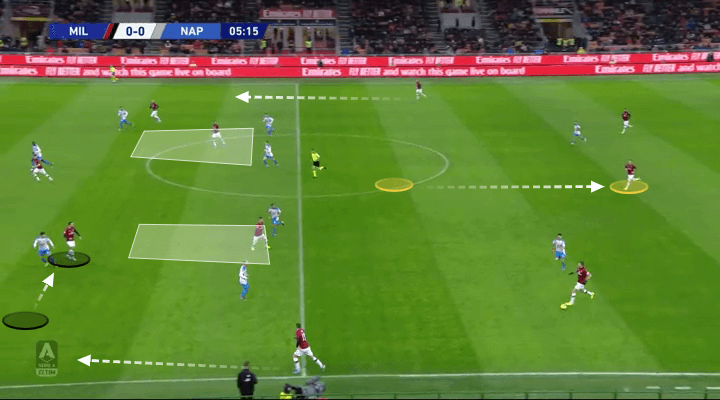
When Milan looked to progress the ball, Biglia would often be the one the centre-backs tried to reach in the first phase. Due to Napoli’s 4-4-2, he was often left unmarked and could receive and turn to play forward. Also, as he received the ball, he often attracted pressure from Allan, leaving space for others to exploit behind Napoli’s midfield. With Biglia, Milan could create a 3 vs 2 advantage against Napoli’s forwards and often progress the ball into midfield relatively easily. We can see one such situation below.

When Biglia then turned, he was very good at finding Paquetá and Krunić in the next line of Milan’s attacking structure. In the image below, we can see how the playmaker finds Paquetá between the lines of Napoli’s midfield and defence. With Bonaventura often joining the aforementioned midfielders between the lines, Milan usually had a good presence in these areas and this allowed them to progress the ball quite well.
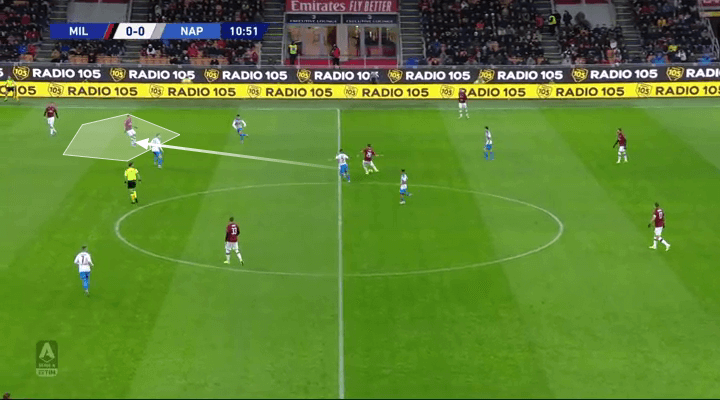
In the second half, Pioli replaced Rebić with Franck Kessié and moved Paquetá to the right with the Ivorian coming into midfield. With the Brazilian now starting out wide, he would repeatedly make movements into the space between the lines to receive in dangerous positions. These movements further strengthened Milan’s presence behind Napoli’s midfield, as the home side were almost attacking in a 4-3-2-1 as seen in the image below. Again, it is Biglia who breaks Napoli’s midfield line to find Paquetá. However, instead of turning and going forward, the Brazilian opted to lay the ball off to the wide run of the right-back Conti.
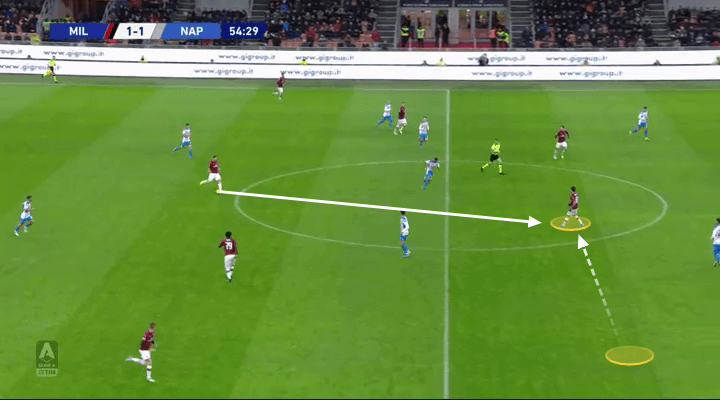
Milan’s changes forced Ancelotti to react, and he did so by replacing Callejón with Dries Mertens as Napoli changed to a 4-5-1 without the ball to deal with Milan’s increased central presence. This worked well, as Napoli now managed to crowd the centre more than they initially had been able to.
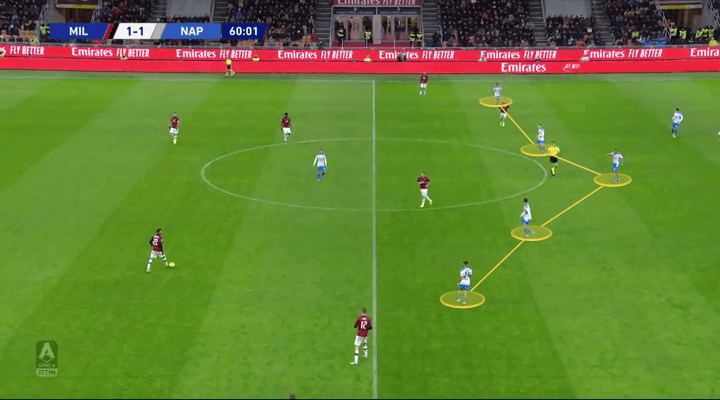
Milan’s build-up play was quite good for most parts of the game, but they lacked quality in the final third. It remains to be seen if Pioli can create some spark and creativity there through his coaching, or if Milan’s players simply cannot provide what the team needs in the final third.
Milan’s pressing
Without the ball, Milan set up in a 4-5-1 which looked to minimise space centrally and force Napoli wide. We can see this aim in the image below. Milan invite the pass out from centre-back to full-back in order to keep Napoli away from the central areas, in which they are often excellent. Therefore, the left-winger Bonaventura remains narrow until the ball is played out wide. The rest of the Milan midfielders shuffle across to block passing lanes in the centre.
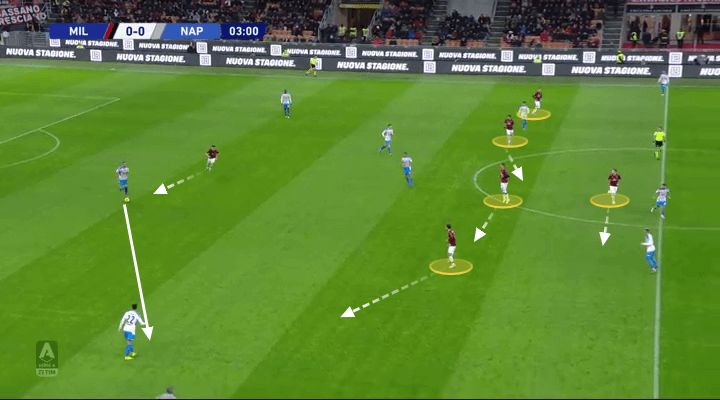
The idea of blocking the centre also becomes clear in the image below. Krunić (yellow) has moved up to press an opponent, and as the ball travels to Kalidou Koulibaly, Kessié is starting to press the Senegalese defender. As a result, Paquetá (white) moves inside to cover for Kessié’s run.
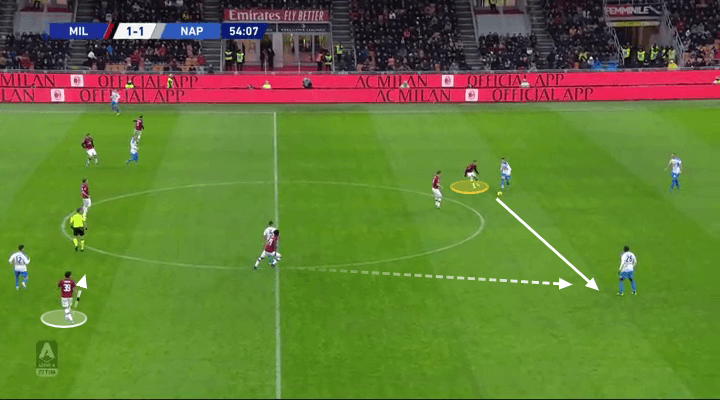
Especially in the second half, Milan would have Kessié leave his position in central midfield and instead move into the first line to press Napoli’s centre-backs. We can see this approach in the image below. As you can see, Biglia and Paquetá again cover for this movement and prevent an easy escape for Napoli into central areas.
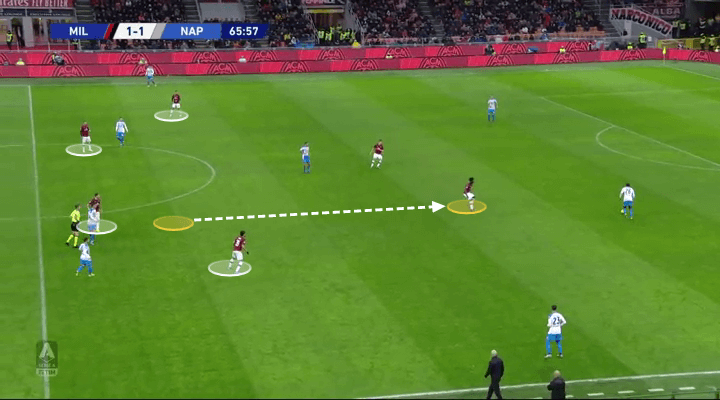
Milan’s pressing worked quite well, and they forced Napoli into uncontrolled long-balls on a number of occasions, but Napoli also managed to break the press in many situations. That is expected though, since they are excellent at building from the back, but what will annoy Pioli is the ease Napoli sometimes escaped the pressure with. One such example is highlighted below, with Nikola Maksimović dribbling out of a difficult situation and initiating a Napoli attack.
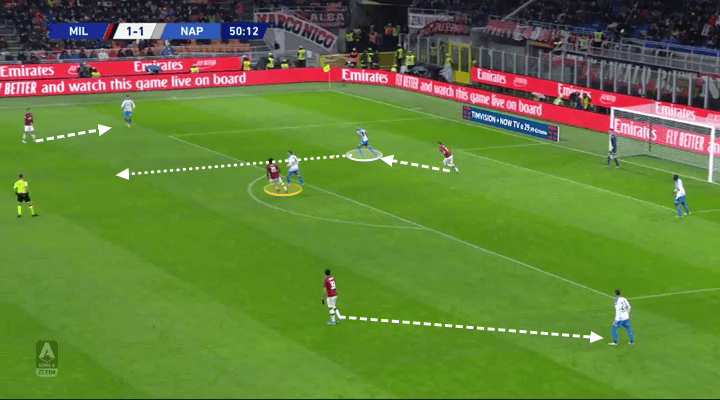
Napoli’s rotations
Napoli under Ancelotti usually show off some interesting rotations, and they used some intriguing ones at the San Siro. From their 4-4-2 base, Elmas would move in off the left to act as a third central midfielder alongside Zieliński and Allan while Callejón would move in from the right and look to find space behind Milan’s midfield. Additionally, Insigne would drop out of the front-two and play as a very fluid number 10, who most often moved into his preferred left-sided half-space. Lozano, therefore, spearheaded the attack on his own while width was provided by the full-backs.
In the image below, we can see the movement of Elmas (yellow at the top of the image) and Callejón (white) as well as Insigne’s (black) deeper position.
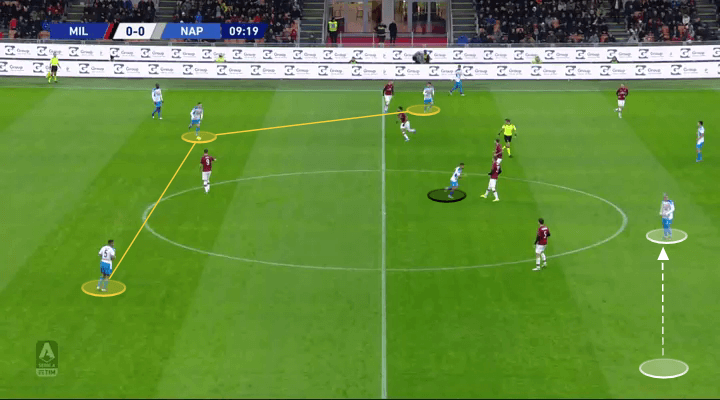
The image below is another example with Elmas forming part of a new three-man midfield while Insigne and Callejón play slightly withdrawn from Lozano.
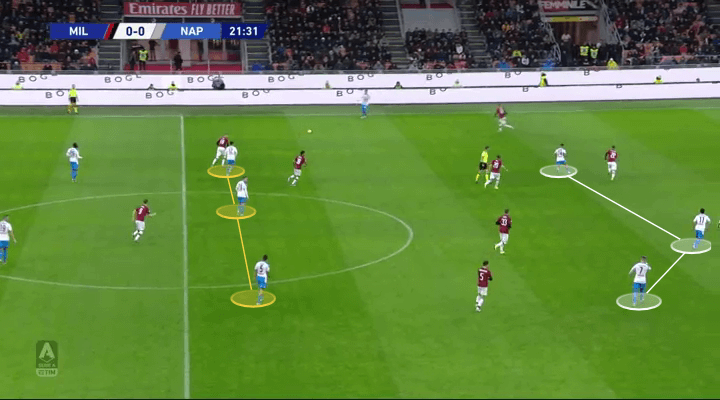
These rotations gave Napoli plenty of options in the central areas, which go some way into explaining why Napoli managed to move the ball so well around the middle third of the pitch. In the image below, we can see their excellent positional structure in attack. However, just like Milan, Napoli did not produce enough quality in the final third to actually create a winner.
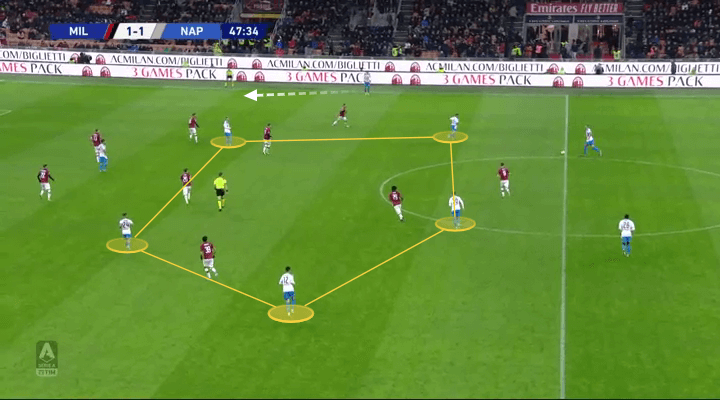
Conclusion
In the end, both sides will be somewhat happy with their performances, particularly in terms of their overall play in possession and how they defended in their defensive thirds, but both will be disappointed with the result. Napoli are now fifteen points behind Juventus, while Milan still languish in the bottom half of the table.

If you love tactical analysis, then you’ll love the digital magazines from totalfootballanalysis.com – a guaranteed 100+ pages of pure tactical analysis covering topics from the Premier League, Serie A, La Liga, Bundesliga and many, many more. Buy your copy of the November issue for just ₤4.99 here





Comments